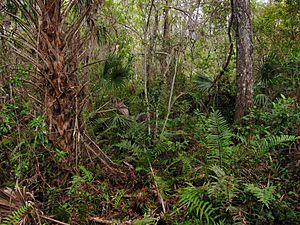Strand swamp facts for kids

A strand swamp is a unique kind of swamp in Florida. It looks like a long, narrow river of trees and water. These swamps form in flat areas where the ground is very wet, and water moves slowly through the trees. Because the land is so flat, the water can't form fast-flowing streams.
Strand swamps are a type of wetland habitat. They are different from cypress dome swamps, which are more round. They are also similar to floodplain swamps, which you might find along rivers further north.
Contents
Where are Strand Swamps Found?
Most strand swamps are found in southern Florida, below Lake Okeechobee. Two famous examples are the Fakahatchee Strand and Corkscrew Swamp.
In Corkscrew Swamp, some trees are incredibly old, up to 700 years! They can also grow very tall, reaching about 30 meters (100 feet). The Fakahatchee Strand is a long channel filled with trees and slow-moving water. It stretches about 32 kilometers (20 miles) long and 8 kilometers (5 miles) wide.
Trees of the Strand Swamp
Many strand swamps are home to bald cypress trees. These trees are very common in these wet areas. In shallower parts of the swamp, you might see pond cypress trees. When either of these cypress trees is the main type of tree, the area is called a "cypress strand."
Sadly, many old cypress trees outside of protected areas in Florida were cut down long ago. Their wood is very strong and resists rotting, which made it valuable.
Water and Peat in the Swamp
Underneath a strand swamp, there are layers of a spongy material called peat. Peat is made from old, decaying plants. In older strand swamps with lots of plants, the peat layers can be very deep.
These deep peat layers are important, especially during dry times. They can act like a sponge, drawing water up from underground. This helps keep the swamp wet even when there hasn't been much rain.
Plants and Animals of the Strand Swamp
Strand swamps are home to many different kinds of plants and animals. They are important habitats for wildlife.
Amazing Plants
You can find many interesting plants in these swamps:
- Air Plants and Vines: Some plants, like common wild-pine, grow on other plants (these are called epiphytes). You might also see vines like white twinevine.
- Water Plants: Plants like giant leather fern and sawgrass thrive in the wet conditions.
- Trees and Shrubs: Besides cypress trees, you can find red maple, pond apple, and the unique strangler fig. Other trees include sweetbay and different types of palms like the Florida royal palm.
Wonderful Animals
Many animals live in strand swamps, relying on the water and plants for survival:
- Reptiles: The Florida redbelly turtle swims in the swamp waters.
- Birds: Large birds like the wood stork and the wild turkey can be seen here.
- Mammals: You might even spot a Florida black bear. The endangered Florida panther also calls these swamps home, making them very important for protecting this rare cat.

